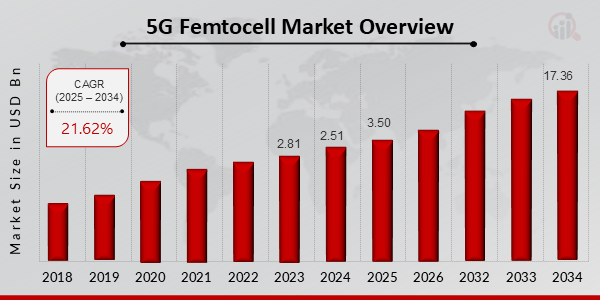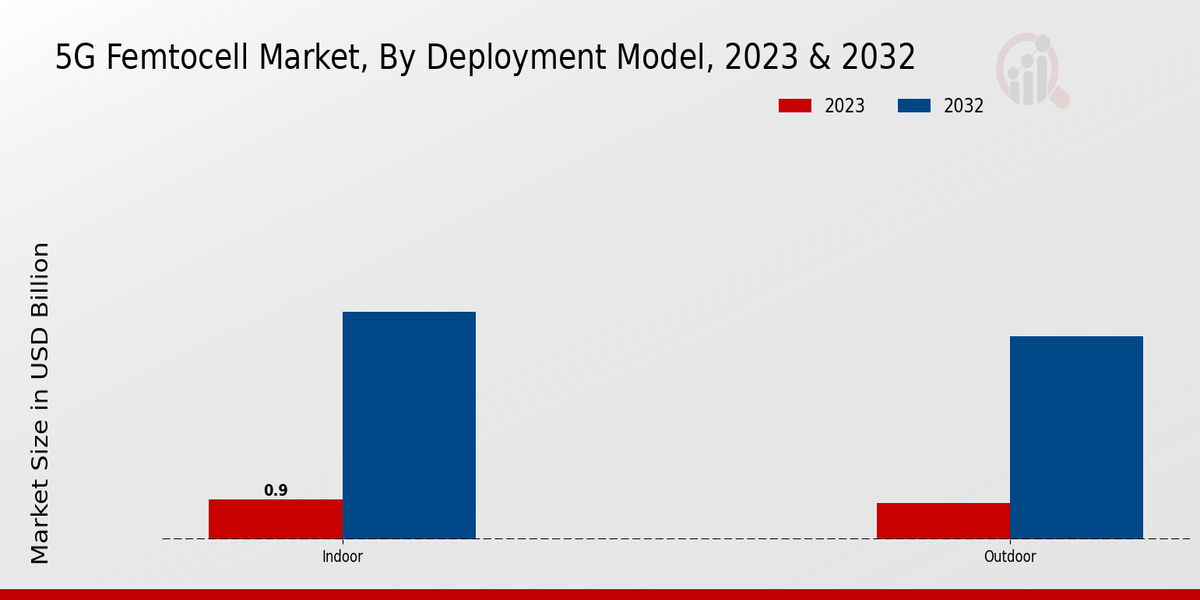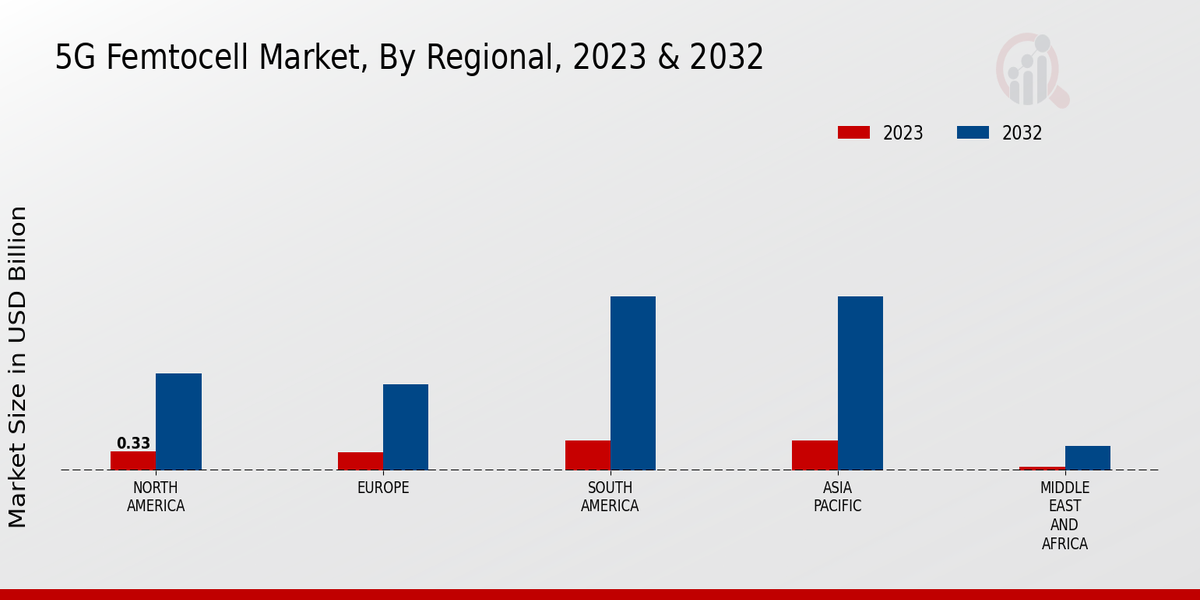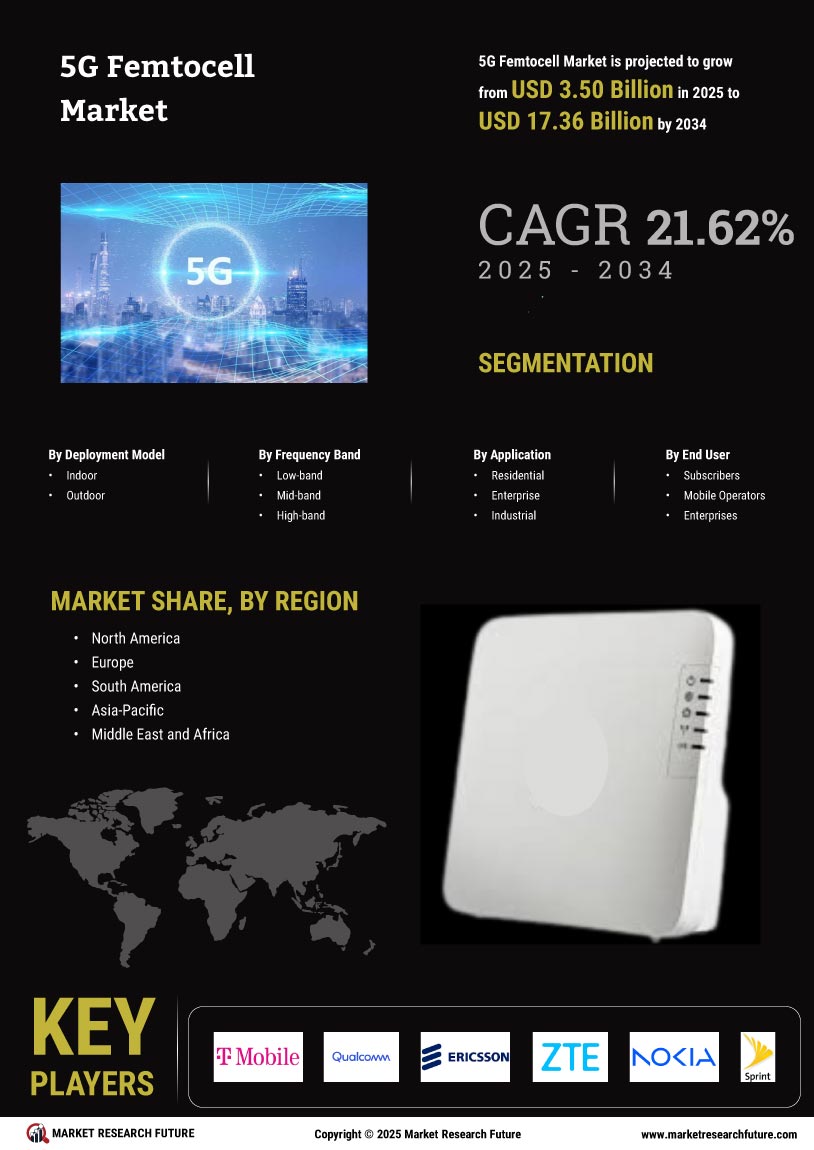5G Femtocell Market Overview
5G Femtocell Market is projected to grow from USD 3.50 Billion in 2025 to USD 17.36 Billion by 2034, exhibiting a compound annual growth rate (CAGR) of 21.62% during the forecast period (2025 - 2034).
Additionally, the market size for 5G Femtocell Market was valued at USD 2.51 billion in 2024.
Key 5G Femtocell Market Trends Highlighted
Enhancing the coverage and capacity of 5G networks is largely dependent on 5G femtocells. The exponential increase in mobile data traffic, the growing need for improved indoor connection, and government measures to improve network infrastructure are the main drivers of the 5G femtocell market's growth.
The market for 5G femtocells is expected to see growth in the integration of machine learning (ML) and artificial intelligence (AI) for network optimization, as well as the creation of small, reasonably priced femtocells that can be deployed in a variety of environments.
The industry has seen recent trends including the installation of 5G femtocells in rural areas to bridge connection gaps and the creation of femtocells with cutting-edge capabilities like beamforming and multi-user MIMO.
Figure 1: 5G Femtocell Market size 2025-2034

Source Primary Research, Secondary Research, MRFR Database and Analyst Review
5G Femtocell Market Drivers
Increasing demand for high-speed internet connectivity
The demand for high-speed internet connectivity is increasing rapidly due to the growing popularity of bandwidth-intensive applications, such as video streaming, online gaming and social networking. This is driving the demand for 5G femtocells, which can provide high-speed internet access in homes and small businesses.
Femtocells can be deployed quickly and easily, making them an ideal solution for areas where wired broadband infrastructure is not available or is too expensive.
In developing countries, 5G femtocells can also provide a cost-effective way to extend broadband coverage to rural and underserved areas.
Increasing demand for high-speed internet connectivity is expected to continue to drive the growth of the 5G Femtocell Market over the next five years.
Growing adoption of IoT devices
The number of IoT devices is growing rapidly and this is expected to continue in the coming years. IoT devices generate a lot of data, which needs to be transmitted back to the cloud for processing. 5G femtocells can provide the high-speed and low-latency connectivity that is needed to support growing number of IoT devices.
Femtocells can also be used to create private networks for IoT devices, which can improve security and reliability. Growing adoption of IoT devices is expected to be a major driver of growth for the 5G Femtocell Market in the coming years.
Government initiatives to promote 5G adoption
Governments around the world are increasingly investing in 5G infrastructure and are providing incentives to encourage the adoption of 5G devices and services. This is expected to lead to a significant increase in the demand for 5G femtocells.
Femtocells can help to extend 5G coverage to areas where it is not possible to deploy macro cells such as indoors and in rural areas. Government initiatives to promote 5G adoption are expected to be a major driver of growth for the 5G Femtocell Market in the coming years.
5G Femtocell Market Segment Insights
5G Femtocell Market Deployment Model Insights
The 5G Femtocell Market is segmented based on the deployment model, both indoor and outdoor. The indoor deployment model is expected to hold a larger market share in the coming years due to the increasing adoption of 5G femtocells in homes and offices.
The growing demand for high-speed internet connectivity, need for improved indoor coverage and rising popularity of smart home devices are driving the growth of the indoor deployment model. The outdoor deployment model is also expected to witness significant growth due to the increasing adoption of 5G femtocells in public areas, such as parks, stadiums and transportation hubs.
Increasing demand for reliable and high-speed internet connectivity in public spaces is driving the growth of the outdoor deployment model. The market growth is attributed to the increasing demand for high-speed internet connectivity, need for improved indoor and outdoor coverage and rising adoption of smart devices.
Figure 2: 5G Femtocell Market By Condition, 2023 & 2032

Source Primary Research, Secondary Research, MRFR Database and Analyst Review
5G Femtocell Market Frequency Band Insights
The 5G Femtocell Market is segmented by frequency band into low-band, mid-band and high-band. Among these segments, the mid-band segment is expected to hold the largest market share in 2023 and is projected to continue its dominance throughout the forecast period.
The mid-band spectrum offers a balance between coverage and capacity, making it suitable for a wide range of applications, including mobile broadband, fixed wireless access and enterprise networks. The low-band segment is expected to witness significant growth due to its ability to provide wide coverage and penetrate through obstacles.
The high-band segment is expected to gain traction in the later stages of the forecast period as it offers extremely high speeds and capacity but has limited coverage and penetration capabilities
5G Femtocell Market Application Insights
The 5G Femtocell Market is expected to reach USD 9.6 billion by 2032, exhibiting a CAGR of 21.06% during the forecast period. Market growth is driven by factors such as increasing demand for high-speed internet connectivity, rising adoption of 5G technology and growing popularity of smart homes and offices.
Based on application, the market is segmented into residential, enterprise and industrial. The residential segment accounted for the largest share of the 5G Femtocell Market revenue in 2023 and is projected to continue its dominance throughout the forecast period.
Growing adoption of 5G-enabled devices, such as smartphones, laptops and tablets, is a major factor driving the growth of this segment. The enterprise segment is expected to witness significant growth during the forecast period, owing to increasing adoption of 5G technology by businesses to improve operational efficiency and productivity.
The industrial segment is also expected to grow steadily, driven by increasing demand for 5G connectivity in industrial applications, such as remote monitoring and control and automation.
5G Femtocell Market End User Insights
The 5G Femtocell Market is segmented by End Users into Subscribers, Mobile Operators and Enterprises. The Subscribers segment is expected to account for the largest revenue share in the market in 2023, with a significant market share of around 55%.
Growth of this segment can be attributed to increasing adoption of 5G-enabled devices by individual consumers for enhanced mobile broadband connectivity and improved user experience. The Mobile Operators segment is also expected to hold a significant market share, owing to rising number of 5G network deployments by mobile operators around the world.
The Enterprises segment is anticipated to have a notable market share and witness steady growth due to the increasing adoption of 5G femtocells for private networks in various industry verticals, such as manufacturing, healthcare and education.
5G Femtocell Market Regional Insights
The 5G Femtocell Market is segmented into North America, Europe, APAC, South America, and MEA based on region. North America held a significant market share in 2023 due to the increasing adoption of 5G technology and the presence of major players in the region.
Europe is projected to witness steady growth over the forecast period, driven by government initiatives and investments in 5G infrastructure.
APAC is expected to be the fastest-growing region, with countries like China and India leading the growth.
South America and MEA are anticipated to have a moderate growth rate during the forecast period.
Figure 3: 5G Femtocell Market By Regional, 2023 & 2032

Source Primary Research, Secondary Research, MRFR Database and Analyst Review
5G Femtocell Market Key Players and Competitive Insights
Major players in the 5G Femtocell Market are continuously developing and launching innovative 5G Femtocell solutions to gain a competitive edge. These players are investing heavily in research and development to enhance their product offerings and expand their market reach.
Leading 5G Femtocell Market players are also focusing on strategic partnerships and collaborations to strengthen their position in the market. The competitive landscape of the 5G Femtocell Market is expected to remain dynamic, with new entrants and established players vying for market share.
Samsung is a prominent competitor in the 5G Femtocell Market, offering a comprehensive portfolio of 5G Femtocell solutions for various applications. The company has a strong presence in key markets and is known for its innovative products and solutions.
Samsung is continuously expanding its 5G Femtocell offerings and investing in research and development to maintain its competitive position.
Nokia is another major player in the 5G Femtocell Market, with a wide range of 5G Femtocell solutions for residential and enterprise applications. The company is known for its reliable and high-performance products and has a strong customer base in various regions.
Nokia is actively involved in 5G Femtocell development and is focused on delivering innovative solutions to meet evolving market demands.
Key Companies in the 5G Femtocell Market Include
-
TMobile US
-
Qualcomm
-
Ericsson
-
ZTE
-
Nokia
-
Sprint
-
AT
-
Verizon
-
Airspan Networks
-
CommScope
-
Siklu Communication
-
Samsung
-
AlcatelLucent
-
Huawei
5G Femtocell Market Developments
The market growth is attributed to the increasing demand for high-speed internet connectivity, the proliferation of IoT devices, and the expansion of 5G networks globally. 5G Femtocells offer several advantages over traditional cellular networks, including improved coverage and capacity, reduced latency, and increased security.
These advantages make them ideal for use in densely populated areas, such as urban centers, office buildings, and shopping malls.
Recent developments in the market include the launch of new 5G Femtocell products by major vendors, such as Huawei, Ericsson, and Nokia. These products offer enhanced features and capabilities, such as support for higher bandwidth and more efficient power consumption.
Additionally, there have been several partnerships and collaborations between 5G Femtocell vendors and mobile network operators to expand the deployment of 5G Femtocells. These developments are expected to drive the growth of the 5G Femtocell Market in the coming years.
5G Femtocell Market Segmentation Insights
5G Femtocell Market Deployment Model Outlook
5G Femtocell Market Frequency Band Outlook
- Low-band
- Mid-band
- High-band
5G Femtocell Market Application Outlook
- Residential
- Enterprise
- Industrial
5G Femtocell Market End User Outlook
- Subscribers
- Mobile Operators
- Enterprises
5G Femtocell Market Regional Outlook
- North America
- Europe
- South America
- Asia-Pacific
- Middle East and Africa
|
Report Attribute/Metric
|
Details
|
|
Market Size 2024
|
2.51 (USD Billion)
|
|
Market Size 2025
|
3.50 (USD Billion)
|
|
Market Size 2034
|
17.36 (USD Billion)
|
|
Compound Annual Growth Rate (CAGR)
|
21.62% (2025 - 2034)
|
|
Report Coverage
|
Revenue Forecast, Competitive Landscape, Growth Factors, and Trends
|
|
Base Year
|
2024
|
|
Market Forecast Period
|
2025 - 2034
|
|
Historical Data
|
2019 - 2023
|
|
Market Forecast Units
|
USD Billion
|
| Key Companies Profiled |
TMobile US, Qualcomm, Ericsson, ZTE, Nokia, Sprint, AT, Verizon, Airspan Networks, CommScope, Siklu Communication, Samsung, AlcatelLucent, Huawei |
| Segments Covered |
Deployment Model, Frequency Band, Application, End User, Regional |
| Key Market Opportunities |
1 Increasing demand for highspeed internet connectivity 2 Growing adoption of 5G devices 3 Expansion of smart home and IoT applications 4 Rise in demand for in-building wireless coverage 5 Government initiatives to promote 5G infrastructure |
| Key Market Dynamics |
Increased demand for highspeed connectivity Growing adoption of IoT devices Government initiatives for smart city development Rise of mobile edge computing Emergence of private 5G networks |
| Countries Covered |
North America, Europe, APAC, South America, MEA |
Frequently Asked Questions (FAQ) :
The 5G Femtocell market is expected to reach USD 9.6 billion by 2032, growing at a CAGR of 21.06% from 2025 to 2034.
The key factors driving the growth of the 5G Femtocell market include the increasing demand for high-speed internet connectivity, the growing adoption of 5G smartphones and devices, and the need for improved indoor coverage.
Asia-Pacific is expected to hold the largest market share in the 5G Femtocell market due to the increasing adoption of 5G technology in countries such as China, India, and Japan.
The key applications of 5G Femtocells include providing indoor coverage for residential and commercial buildings, extending the reach of 5G networks, and offloading traffic from macro cells.
The key competitors in the 5G Femtocell market include Huawei, Ericsson, Nokia, Qualcomm, and Cisco.
The challenges facing the 5G Femtocell market include the high cost of deployment, the lack of interoperability between different vendors' Femtocells, and the need for skilled personnel to manage and maintain Femtocell networks.
The opportunities for the 5G Femtocell market include the growing demand for high-speed internet connectivity, the increasing adoption of 5G smartphones and devices, and the need for improved indoor coverage.
The key trends in the 5G Femtocell market include the increasing adoption of cloud-based Femtocell solutions, the growing use of Femtocells in enterprise applications, and the emergence of new technologies such as millimeter wave (mmWave) Femtocells.
The 5G Femtocell market is expected to Register a CAGR of 21.06% from 2025 to 2034.
The key factors that will shape the future of the 5G Femtocell market include the increasing demand for high-speed internet connectivity, the growing adoption of 5G smartphones and devices, the need for improved indoor coverage, and the development of new technologies such as millimeter wave (mmWave) Femtocells.

















